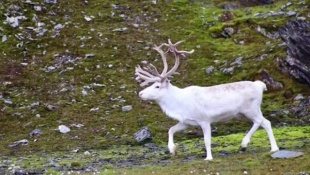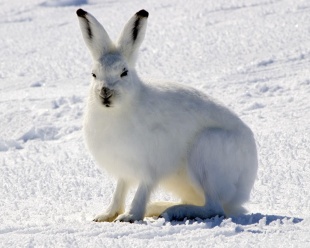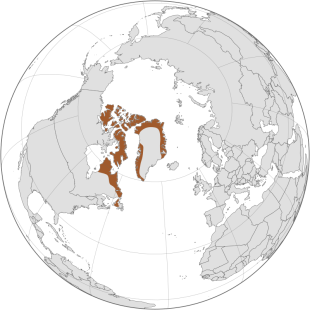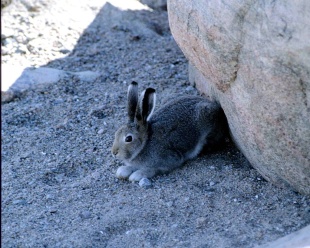ARCTIC ANIMALS THAT TURN WHITE IN THE WINTER
Some animals in the Arctic and other places with a lot of snow turn to white in the winter and change back to their original color after the snow melts. These animals are vulnerable to attacks from predators in the spring when they are still white and their world is dark colored. The same holds true to some degree in the autumn after the first snow and they are still dark colored. Camouflage is important for animals living in the tundra because there are no trees of large bushes or anything else that be used as cover or hide behind.
Animals that turn white for winter include Arctic foxes, Arctic hares, snowshoe hares, ptarmigan, caribou and ermine. M. Saleem wrote in webecoist.com: “Starting in September, the Arctic Fox sheds its brown coat, opting instead for a white one to help it through the inter. As summer begins to approach again, the white coat is once again replaced with a brown one, allowing it to hide better in the earthy tones of its habitat. [Source: webecoist.momtastic.com ***]
“Just as with the Arctic Fox, the transformation in the Arctic Hare is an absolute one. Though they are brown with flecks of black during the summer, they turn a beautiful and pure white during the winter months. This not only helps them keep warm but provides much needed camouflage in the snow when they come out of their nests or burrows. The Ermine, also known as the short-tailed weasel, is the smallest member of the weasel family. They are found all over the Arctic regions of Asia, Europe, and North America. ***
“The Ptarmigan, or Rock Ptarmigan as it is known in North America, is a popular game bird that molts from brown to white with the exception of the tail which retains its original color of brown or black. These birds prefer higher elevations and barren regions, and are often found perched in rocks or sitting in the snow (hiding) than in trees where they could be spotted easily in the winter. ***
“In general, the coat of the Caribou alternates between brown and white, but it is never wholly one or the other. In the summer time it is predominantly brown but the neck region retains a dirty white color, while in the winter, the white spreads and becomes clearer though the brown never completely goes away. This difference in the degrees of color change varies depending on the regional habitats of the Caribou.” ***
RELATED ARTICLES:
TUNDRA factsanddetails.com
MUSKOXEN: CHARACTERISTICS, HISTORY, BEHAVIOR AND REPRODUCTION factsanddetails.com
ARCTIC GROUND SQUIRREL CHARACTERISTICS, BEHAVIOR, EXTRAORDINARY HIBERNATION factsanddetails.com
REINDEER AND CARIBOU: CHARACTERISTICS, FEEDING, CONSERVATION factsanddetails.com
REINDEER AND CARIBOU BEHAVIOR: MIGRATIONS, REPRODUCTION, PREDATORS factsanddetails.com
POLAR BEARS: CHARACTERISTICS, BEHAVIOR AND REPRODUCTION factsanddetails.com
POLAR BEARS, HUMANS. CONSERVATION: CLIMATE CHANGE, POLLUTION, TOURISM factsanddetails.com
POLAR BEARS ATTACKS: CIRCUMSTANCES AND BEHAVIOR OF THE BEARS AND HUMANS factsanddetails.com
POLAR BEARS ATTACKS REPORTED IN THE MEDIA factsanddetails.com
SNOWY OWLS: CHARACTERISTICS, BEHAVIOR AND REPRODUCTION factsanddetails.com
Arctic Hares
Arctic hares, or polar rabbits, are hares which have adapted harsh polar and mountainous conditions. habitats. They have thick coats of fur and usually dig holes in the ground or under snow to keep warm and sleep. Arctic hares look like rabbits but have shorter ears, are taller when standing. They can travel together with many other hares, sometimes huddling with dozens or more, but are usually found alone. The Arctic hare can run up to 60 kilometres per hour (40 mph). Typically they 48 to 67 centimeters (19 to 26 inches) long with a three to eight centimeter long tail and weigh three to seven kilograms (6 to 15 pounds).
According to National Geographic: “The arctic hare lives in the harsh environment of the North American tundra. These hares do not hibernate, but survive the dangerous cold with a number of behavioral and physiological adaptations. They sport thick fur and enjoy a low surface area to volume ratio that conserves body heat, most evident in their shortened ears. Hares are a bit larger than rabbits, and they typically have taller hind legs and longer ears. [Source: National Geographic]
In winter, they sport a brilliant white coat that provides excellent camouflage in the land of ice and snow. In spring, the hare's colors change to blue-gray in approximation of local rocks and vegetation. Arctic hares are sometimes loners but they can also be found in groups of dozens, hundreds, or even thousands of individuals.
Unlike many mammals, arctic hare groups disperse rather than form during mating season. Animals pair off and define mating territories, though a male may take more than one female partner. Females give birth to one litter per year, in spring or early summer. Two to eight young hares grow quickly and by September resemble their parents. They will be ready to breed the following year.
Food can be scarce in the Arctic, but the hares survive by eating woody plants, mosses, and lichens which they may dig through the snow to find in winter. In other seasons they eat buds, berries, leaves, roots, and bark. Traditionally, the arctic hare has been important to Native Americans. These fairly plentiful animals are hunted as a food resource and for their fur, which is used to make clothing.
Arctic Foxes
Arctic foxes (Vulpes lagopus) range farther north than any other land mammal and are the smallest wild canid found in northern latitudes. About the size of a large domestic cat, they hunt lemmings underneath the snow even though they can’t see them. Arctic foxes range across the entire Arctic region and probably total several hundred thousand but their numbers vary with wide fluctuations because of variations in the lemming populations. Most arctic foxes turn white in winter, but some have brownish blue fur. Many bluish one live in coastal areas, where they blend into dark backgrounds. Around July white foxes shed their winter coats for the brown and cream fur of summer. White foxes can be easily seen against the black earth in the summer. Blue foxes also turn dark brown that time of year. [Source: John L. Eliot, National Geographic, October 2004
Arctic foxes are also known as white foxes, polar foxes, and snow foxes. They make up their own small fox species and are native to the Arctic regions where they are fairly common in tundra environments. Their adaptions for cold environments include rounded body shape that minimize the escape of body heat and thick, warm, fur that serves as camouflage as it often matches their surroundings. In the wild, most individuals do not live past their first year but some hardy individuals survive up to 11 years. Arctic foxes have lived over 16 years in captivity. [Source: Wikipedia +]
Arctic fox preys on many small creatures such as lemmings, voles, ringed seal pups, fish, waterfowl, and seabirds. They also eats carrion, berries, seaweed, and insects and other small invertebrates. Natural predators of the Arctic fox are golden eagles, Arctic wolves, polar bears, wolverines, red foxes, and grizzly bears. The origins of the Arctic fox appear to be "out of Tibet" hypothesis. Fossils of the extinct ancestral Arctic fox (Vulpes qiuzhudingi), dated to the early Pliocene (5–3.6 Million years ago) have been found on the Tibetan Plateau along with many other precursors of modern mammals that evolved during the Pliocene. Globally, the Pliocene was about 2–3 °C warmer than today, and the Arctic during the summer was 8 °C warmer. By using stable carbon and oxygen isotope analysis of fossils, researchers claim that the Tibetan Plateau experienced tundra-like conditions during the Pliocene and harbored cold-adapted mammals that later spread to North America and Eurasia during the Pleistocene Epoch (2.6 million-11,700 years ago). +
See Separate Article ARCTIC FOXES: CHARACTERISTICS, BEHAVIOR AND REPRODUCTION factsanddetails.com
Lemmings
Lemmings are small, short-tailed rodents that look like fat, furry mouses. Usually found in or near the Arctic in tundra biomes, they form the subfamily Arvicolinae (also known as Microtinae and sometimes referred to as the meadow mouse family) together with voles and muskrats. Residing in some of the world's coldest places without hibernating, lemmings survive in the summer by eating lichens and mosses and survive the winter by burrowing themselves under the snow. Lemming are 1) Muroidea, a large and complex superfamily of rodents, including mice, rats, voles, hamsters, lemmings, gerbils, and many other relatives, and 2) Cricetidae, a family of rodents within Muroidea. Muroidea includes true hamsters, voles, lemmings, muskrats, and New World rats and mice. At over 870 species, it is either the largest or second-largest family of mammals, and has members throughout the Americas, Europe and Asia.
Lemming are very prolific. They can became pregnant at the age of 14 days (more often around two months) and can reproduce five or six liters of 4 to 6 offspring annually. The gestation period is only thee weeks. According to the Guinness Book of Records, one pair produced eight litters in 167 days. Theoretically a single pair of lemmings could produce 10,000 lemmings in a single years, Oredatris and lack of food are the main factors that keep their numbers in check. Frequently the animals over produce to the point they outstrip the food supply.
Lemming populations surge and crash with a high degree of regularity at intervals of about once every four years. In a very short period the numbers of lemmings dramatically increase and then virtually disappear. In the 1500s, it was seriously suggested that lemming dropped from the sky. No other plausible explanations could be offered as to why their population could increase so much so suddenly.
RELATED ARTICLES:
LEMMING BOOM-AND-BUST REPRODUCTION AND MYTHS ABOUT MASS SUICIDE factsanddetails.com
LEMMING SPECIES factsanddetails.com
NORWAY LEMMINGS: CHARACTERISTICS, BEHAVIOR AND REPRODUCTION factsanddetails.com
STEPPE LEMMINGS: CHARACTERISTICS, BEHAVIOR AND REPRODUCTION factsanddetails.com
Image Sources: Wikimedia Commons
Text Sources: Animal Diversity Web animaldiversity.org ; National Geographic, Live Science, Natural History magazine, David Attenborough books, New York Times, Washington Post, Los Angeles Times, Smithsonian magazine, Discover magazine, The New Yorker, Time, BBC, CNN, Reuters, Associated Press, AFP, Lonely Planet Guides, Wikipedia, The Guardian, Top Secret Animal Attack Files website and various books and other publications.
Last updated June 2025




